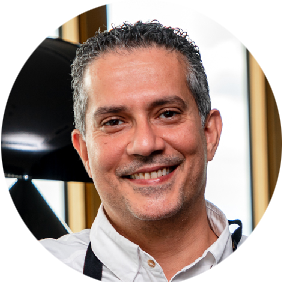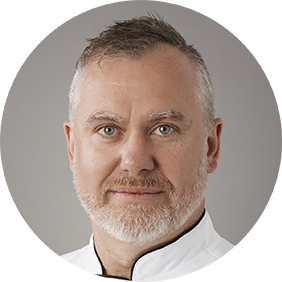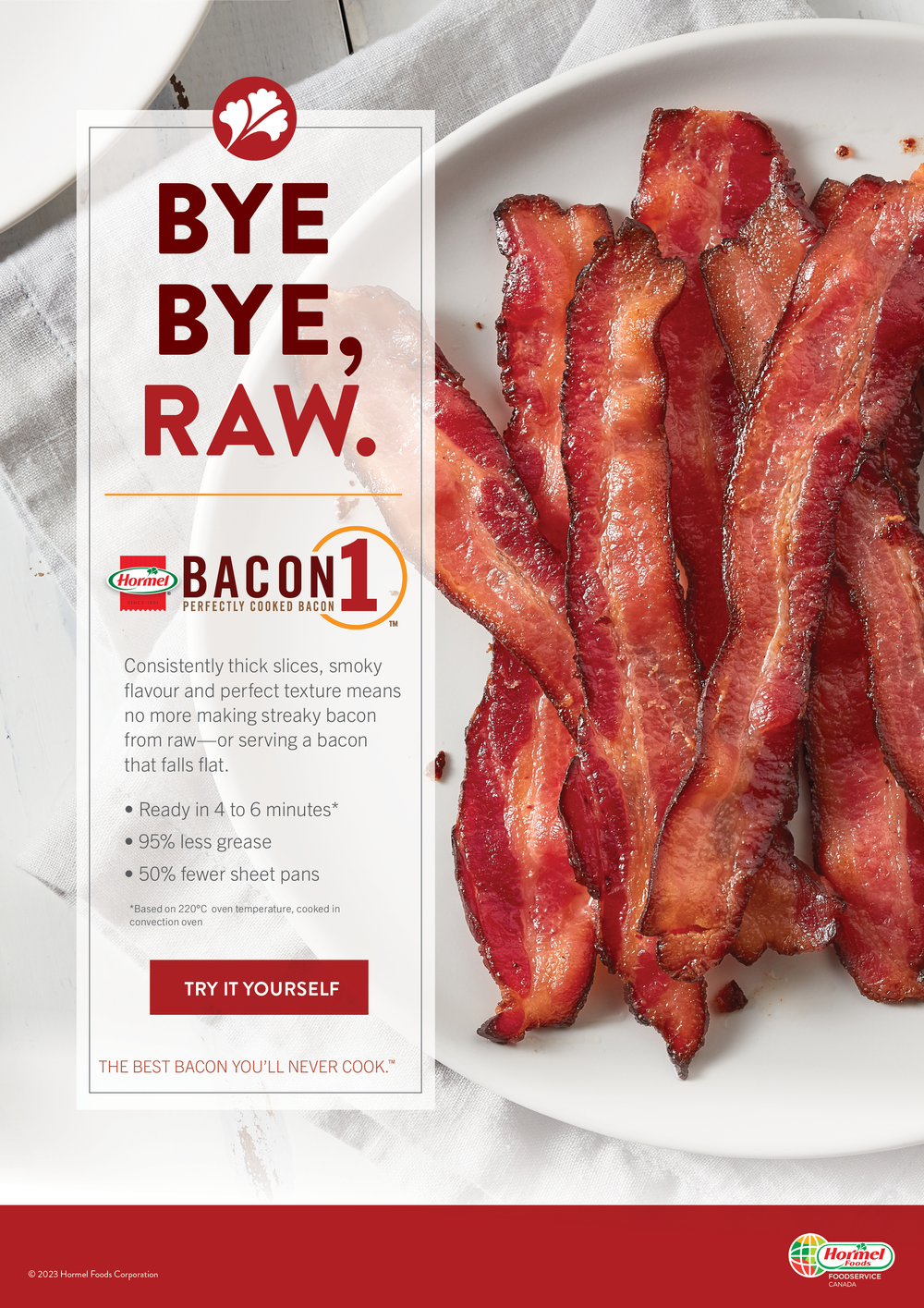INSIDE FOODSERVICE Menu planning and effective ordering
/Chefs George Diamond, Markus Werner and Paul Rifkin on effective menu planning, stock management, wastage minimisation and more.
George DIAMONd
George Diamond, Group Executive Chef at Trippas White Group. emphasises it’s common knowledge that foodservice has been beset by significant price increases across all product categories. “Seafood, poultry, beef, lamb and pork freight costs have shot up, and even imported product from Europe and Asia is costing a lot more to bring over to Australia than previously. Distributors are passing those costs on, and that makes menu planning a challenging process.
“The beauty of a business like ours is we have the ability to negotiate based on our volumes, and high volumes equals better pricing for your clientele. We have a team led by our group procurement manager Matthew Beaumont and myself who work closely together to negotiate and deliver product and the three most important things we look at are firstly quality, secondly availability and thirdly price.
Revise menus seasonally
To ensure effective supply chain management, George and his team revise menus seasonally – every three months. “For example with our fruit and veg, every three months we look at a product tender and that gives us the ability to put produce on at its very best and best seasonal price. So you won’t see us putting tomatoes on in winter when the prices are high, or lime or oranges in summer. We know historically pork always goes up at Christmas, so we estimate what we’re going to need for the festive season well in advance and because we manage our pricepoints on a quarterly basis we're able to work very closely with the supplier to get the best outcome and at the end of the day it’s the customer who benefits.”
“I would always recommend you work with your supplier and let them educate you about what’s in season, what’s great value, what’s super tasty”
— George Diamond
Even for smaller operations which can’t compete on buying power, George says building and maintaining a close relationship with suppliers is paramount. “When I'm writing menus for Esq at QVB I’ll talk to my seafood supplier and ask, what’s in season at the moment that’s really good? And they might say bonitos is fabulous right now, or that they can get me a beautiful piece of mulloway. They know what’s plentiful on the market floor, whether it's beautiful scallops from Abrolhos Island over in WA or from Port Lincoln. So I would always recommend you work with your supplier and let them educate you about what’s in season, what’s great value, what’s super tasty and best to eat in that period. As a result of that you then start writing your menu.
“Once our chefs have written theirs I’ll work closely with them and then we start getting the ingredients in and developing those dishes over time – perfecting them and putting them on the specials list to get customer feedback, making sure the flavour profile, presentation and texture is up where it needs to be. Then we'll then cost up the menus which is a super important step so we know exactly what they cost to put on the plate, which then determines what we can sell those dishes for.
“We run daily pop quizzes to make sure our FOH and BOH team know our menus intimately”
“Then when the menus have had final approval after multiple tastings with stakeholders, the chef needs to create standardised recipes for both front of house and back of house staff. For FOH we’ll do a menu matrix and allergen matrix so that the staff know exactly how to answer questions from customers with particular dietary requirements or in relation to the presence of allergens such as tree nuts or peanuts. Our chefs also train the FOH staff through the provision of menu notes, they conduct tastings, they put menu photos and specs on Powerpoint presentations for the staff to take home and learn. We also run additional training sessions when required and even daily pop quizzes to make sure our FOH and BOH team know our menus intimately. As always, the aim is to ensure that the customer has the best experience possible. It’s not a good look for staff to have to go back to the kitchen and check when a customer asks a question, so we train our staff to have an intimate knowledge of the menu. It also promotes staff retention in that our chefs and FOH staff know they’re actually expanding their knowledge base.”
Drive up the local offers, use brand recognition
MARKUS WERNER
Markus Werner is Culinary Director for Delaware North Australia, in which role he is extensively involved in menu planning and procurement for the group. Markus says a key driver for the business is to feature local produce, which came to the forefront of consumer attention as Covid adversely impacted international supply chains.
“We are wanting to support and drive more the local offers and use brand recognition which is very important. More generally I think menus are going a bit simpler - perhaps because people are dining out less, it’s certainly the case that the product is the hero and you shouldn’t play around too much with it.
“Our focus is on using high end ingredients and making sure the products we're using are presented to the best of our ability. Especially for mains, the protein should be local and really made the hero of the dish as opposed to putting lots of toppings and sauces which totally change the texture and quality.
“The protein should be local and really made the hero of the dish as opposed to putting lots of toppings and sauces which totally change the texture and quality”
— Markus Werner
“Once we came out of Covid, the service hours changed so the menu had to change too, because we no longer have three days’ time to prep everything up. Now you really have to consider when are the premium times for customers to come, and when is the time to shut down the kitchen.
“There are so many restaurants now only open four nights a week, so they can make sure they have the same crew and no one’s working more than 40 hours. The days when you would do 100 hours in the kitchen are gone – it’s a better work-life balance now.
“I think foodservice is always going to be a profession where you need passion, drive and love of what you’re doing, but the values of family and home have to be considered. So you can’t prep 50 main courses, you’ll probably have only eight to 10 and you also have less people in your brigade. All this means we need to streamline the menu in order to maintain high quality – no one really wants those old 10 page long menus anymore anyway.”
Markus cites waste management as another key consideration post-Covid – “fridges and freezer stock are more limited now, so you really need to make sure you're using every single part of the animal or even any vegies, such as by making your own stocks again. So it’s kind of back to basics which is great – I think now is a great time to be in hospitality, because you’re getting paid more, the quality of chefs is better again, you can make your own stocks and terrines, your menu is smaller so you can concentrate more on each dish, and because everything’s more expensive you need to control your wastage more carefully. So use all the bones of the meat for bone broths, use every single ingredient to its maximum potential.”
Cost to plate has changed dramatically
PAUL RIFKIN
Paul Rifkin spent 17 years as executive chef at Campbelltown Catholic Club, where he was actively involved in the design, construction and menus of eight new kitchens including a hotel, convention centre, restaurants and event spaces. Today he spends much of his time consulting to foodservice operations, including undertaking three day audits of venues such as clubs - see his website www.chefpaulrifkin.com.au for more details.
“There are a lot of managers out there who say their customers expect good portion sizes, but they’re not looking at what’s on the plates when they come back to the kitchen”
— Paul Rifkin
“Covid certainly played havoc with our supply chains, but now the price of product is stabilised or falling, however the cost to put it on the plate has changed dramatically with rising wages,” Paul says.
He emphasises that a key element of sound menu planning is to check your portion sizes and that this is more important than ever right now. “You need to bear in mind that if your mains are so large that people are cutting it in half and asking for two plates – which sounds funny but it’s something I’m seeing in the club market – they might pay $26 for one main but they won’t be ordering an entrée or a dessert because everyone’s full. So you need to be monitoring plate wastage – what goes out versus what’s left behind. Unfortunately there are a lot of managers out there who say their customers expect good portion sizes, but they’re not looking at what’s on the plates when they come back to the kitchen.
“It’s not about fattening the customers up on any particular dish, it’s about dollars per head – that’s the only way you’re going to make money”
“The classic case is serves of hot chips – I see probably up to 50 per cent of chips coming back, and now the price of chips has gone so high it doesn’t even make sense to do that. So it’s never been more important to work out your portion sizes according to cost and profitability. It’s not about fattening the customers up on any particular dish, it’s about dollars per head – that’s the only way you’re going to make money.
“I always tell foodservice businesses, you should only be holding one week of stock – OK, if there's some units you get short-stocked on you might hold two to three weeks’ supply. But when you walk into a place and they’re holding literally a month’s worth and they say, ‘we bought it up because it’s so cheap’, but the price has fallen by 30 per cent since then, and the problem is you still have to move the stock. You can’t afford to compromise storage space like this, you have to manage what you’ve got.
“Unfortunately there’s a lot of inexperience out there right now – a lot of good people left the industry during Covid, and the person who’s the CEO or the business owner doesn’t always know what’s happening in the kitchen. It’s important to get in there and find out, or hire someone to go in and find out what’s going on, and then you can put some steps and processes in place to improve efficiency.
“Even experienced people can’t always focus well when they’re under pressure, and with the staff shortages in the industry a lot of people have been working way too hard to be able to maintain any level of perfection. There hasn’t necessarily been the right support everywhere and some of that is now coming back to bite people - a lot of head chefs have been moving around trying to find greener pastures. But in saying that there's also lots of businesses out there who are running things well. And it really comes down to what their processes and procedures are, and to what extent they're being monitored.”












